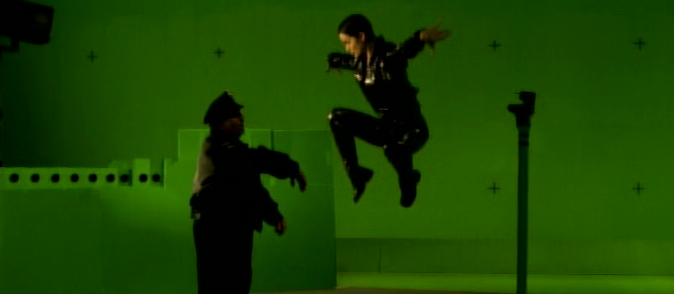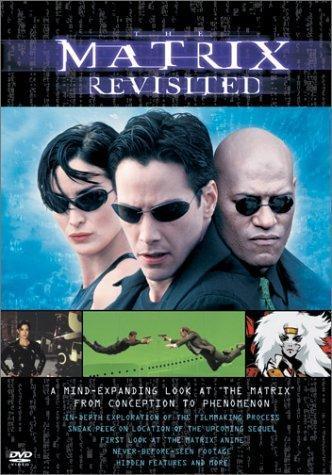

“You kind of die a little bit every time you finish a film.”
The Matrix Revisited is a behind the scenes look at the making of The Matrix, one of the most groundbreaking science fiction films of all time. Helmed by Josh Oreck, it details the struggles the Wachowskis had getting their comics-influenced vision greenlit, the entire production, and the aftermath. It is fairly expansive, detailing fight choreography, physical conditioning, philosophical influences, visual effects, casting, wardrobe, cultural impact, fandom, etc. There’s archival footage and then-current interviews with cast and crew who were on-set filming the sequels.1
In order to secure the trust of studio execs to fork over the dough for The Matrix, the Wachowskis directed the low-budget Bound to cut their teeth. According to the interviews on the documentary, almost everyone liked the script of The Matrix, but almost no one completely grasped exactly what the filmmakers wanted to appear on screen.2 Because of this, they storyboarded the entire film, bringing on Geof Darrow (Hard Boiled) to create concept art. His aesthetic nearly perfectly matches the vision of the Wachowskis; there are drawings displayed here that are mirror images of the scenes from the film, and the documentary is edited to showcase how well the visuals were captured by Darrow. Regarding the visual style they were going for in action scenes, inspired by anime films such as Akira and Ghost in the Shell, Larry Wachowski (who now goes by the name Lana) said:
“We were speaking before of the impact that comic books can have in terms of their frozen graphic moments. What we really like about slow motion is that it brings some of that quality to action scenes. But what we also like is to move the camera; so we started off with this concept of shooting in slow motion and moving the camera at regular speed.”

Eventually they brought in John Gaeta, who created an entirely new filmmaking technique that has since become known as “bullet time.” Early test footage is shown of a trash can exploding as the camera revolves around it.
In order to instill the correct mindset, the Wachowskis asked Reeves to read several books before even touching the script. Reeves mentions Kevin Kelly’s Out of Control, which theorizes that intelligence is not concentrated in any centralized structure, but spread out amongst many smaller components, touching on cybernetics, self-organization, and chaos theory; Introducing Evolutionary Psychology by Dylan Evans and Oscar Zarate; and Jean Baudrillard’s Simulacra and Simulation (which actually shows up as a prop in the film), a text that examines symbolism and technology.
The physical conditioning and fight choreography are covered extensively. Reeves had recently undergone spinal fusion surgery and wears a neck brace in much of the training footage. Fight choreographer Yuen Woo-Ping is interviewed along with members of the main cast, discussing the grueling training sessions that the Wachowskis requested so that the actors could do all of the fight scenes themselves (they still had stuntmen for getting slammed into walls and things like that). Woo-Ping worked with his own team and the Wachowskis to define the scenes and the choreography before training the actors, and there is an amusing scene in the doc where they are setting up the scene in which Neo and Agent Smith collide in mid-air. Partway through staging it, the Wachowskis realize that Woo-ping is setting it up to be two separate shots, when they envisioned it as one.

Throughout, the Wachowskis are wonderfully nonchalant, but uncompromising in their vision. They seem to be genuinely having fun as they encourage all of these professionals to bring their unique vision to life, and remain unrattled through all of the setbacks. It is also amazing how aligned they are; at no point do they contradict each other, and always seem to be on the same page, as if the same exact film existed fully formed in both of their minds.
Carrie-Anne Moss and Keanu Reeves both seem to go through some physical and mental struggles during filming—Reeves with his neck injury and Moss constantly feeling that the role is beyond her capabilities—but Laurence Fishburne seems perpetually upbeat, playing harmonica in between sessions, joking with everyone, and enjoying the training process; he even compares the process to his experience filming Apocalypse Now, a film with a production process that is the stuff of legends.
The best part of the documentary is the second half, where several of the epic set pieces are detailed. They step through the technique used to freeze the Matrix. We see footage of how they shot the “dodge this!” scene, the limbo scene, the dojo scene, and the helicopter scene. There is a neat anecdote of Carrie-Anne Moss choosing to replace her stunt double for a scene because it “just didn’t feel right” having the stuntwoman doing it. One of my favorite moments is when crew members are describing the difficulty of the helicopter rescue scene, detailing how complex it was to recycle and sterilize the water to make it safe for a hundred cast and crew to have the same water raining down on them repeatedly. Contrasting the concerned and detailed explanation of the logistics required to film the scene, the doc then cuts to the Wachowskis. Larry says, “And you forget about the helicopter coming down and shooting.” To which Andy (now Lilly) responds, “Ohhh yeahhh.”

Though less exciting than how to film a helicopter crash or the technique to achieve bullet time, the documentary also covers sound design and the editing process, both very underappreciated but crucial parts of the filmmaking process. In pointing out the soundtrack selections, it becomes clear just how perfectly the music choices fit the film.
Toward the end of the doc, some of the cast and crew react to the finished product. It is neat to see how devoted and involved they were with its creation yet how moving the final product was to them; Fishburne especially notes how the philosophical undercurrents were very impactful for him when viewing the finished film for the first time.
Like most behind-the-scenes documentaries, it’s probably only truly enjoyable for fairly devoted fans. It gives the audience things to look for when they watch the film again, and you’ll walk away with a greater appreciate for what the young directors pulled off with The Matrix.
1. There are interviews from the directors, producer Joel Silver, cinematographer Bill Pope, editor Zach Staenberg, fight choreographer Yuen Woo-ping, concept artist Geof Darrow, and several members of the main cast, among others.
2. Except for Laurence Fishburne, who apparently understood it perfectly the first time he read it.